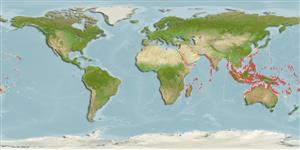Preferred temperature (Tài liệu tham khảo
123201): 25.7 - 29.2, mean 28.5 °C (based on 3040 cells).
Phylogenetic diversity index (Tài liệu tham khảo
82804): PD
50 = 0.5000 [Uniqueness, from 0.5 = low to 2.0 = high].
Bayesian length-weight: a=0.01479 (0.01239 - 0.01766), b=2.98 (2.94 - 3.02), in cm total length, based on LWR estimates for this species (Ref.
93245).
Mức dinh dưỡng (Tài liệu tham khảo
69278): 3.6 ±0.5 se; based on diet studies.
Thích nghi nhanh (Tài liệu tham khảo
120179): Trung bình, thời gian nhân đôi của chủng quần tối thiểu là 1.4 - 4.4 năm (K=0.45-0.49; tmax=15).
Prior r = 0.58, 95% CL = 0.38 - 0.87, Based on 1 data-limited stock assessment.
Fishing Vulnerability (Ref.
59153): Low to moderate vulnerability (31 of 100).
🛈
Climate Vulnerability (Ref.
125649): Very high vulnerability (79 of 100).
🛈
Nutrients (Ref.
124155): Calcium = 49.7 [34.2, 75.8] mg/100g; Iron = 0.885 [0.562, 1.363] mg/100g; Protein = 20.5 [18.0, 22.8] %; Omega3 = 0.128 [0.087, 0.187] g/100g; Selenium = 34.2 [20.1, 62.6] μg/100g; VitaminA = 24.1 [4.9, 137.6] μg/100g; Zinc = 2.54 [1.84, 3.36] mg/100g (wet weight);
